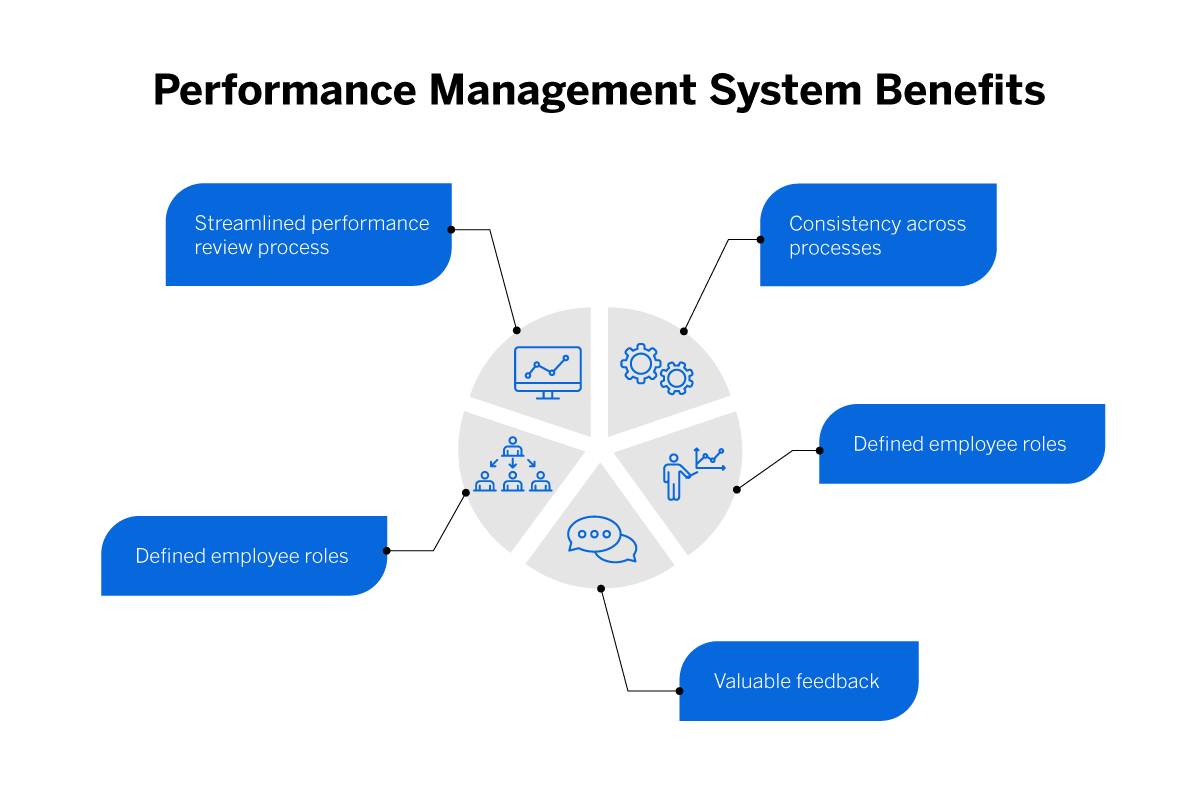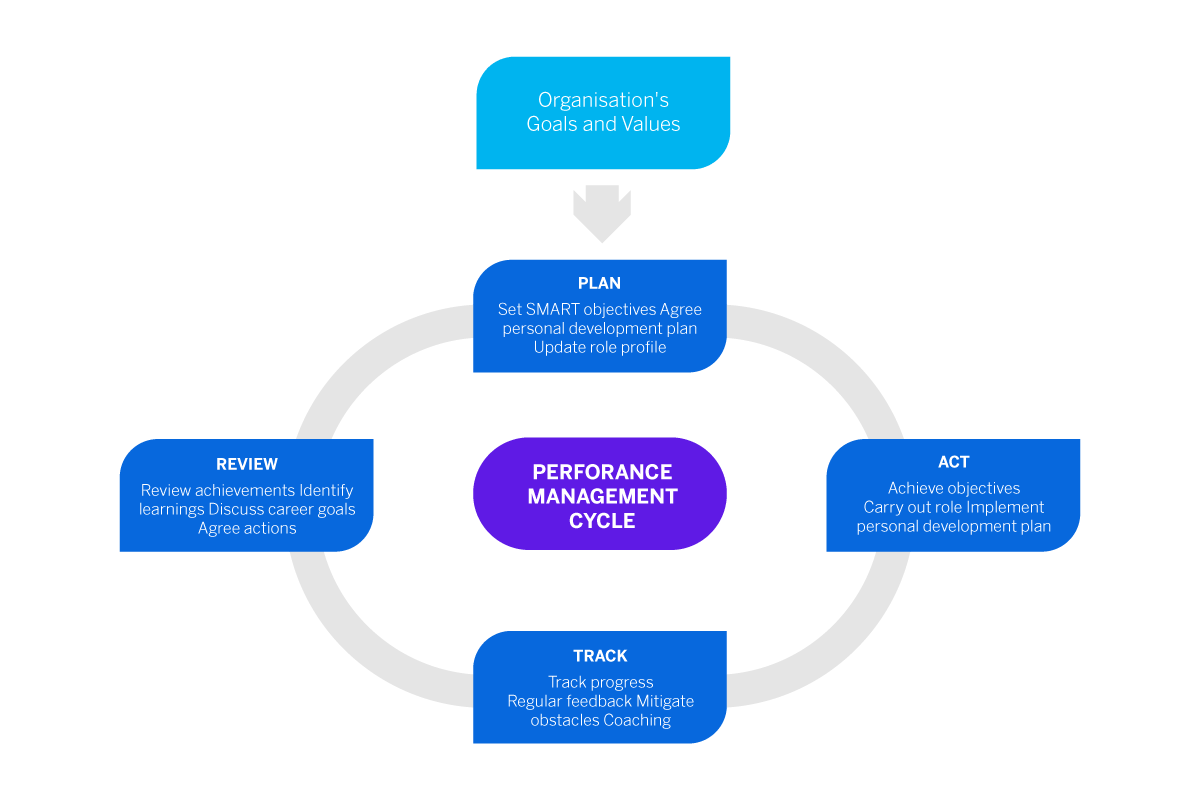
Performance management definition
Performance management is a crucial aspect of any successful business. It involves establishing objectives, improving performance, and ensuring employee accountability. The way performance management is conducted depends on your company culture. Whether you have a traditional, bottom-line-driven hierarchy or a collaborative and agile environment, the goal remains the same: supporting employees to achieve their individual goals for the benefit of the organization.
What is the business impact of performance management?
More talent retention
Retaining talented employees is essential for the success of your business. Replacing an employee can be costly, and preventable voluntary resignations can have a significant impact. By implementing a performance management system that allows employees to continuously work towards their goals and provide feedback, you create an environment that motivates them to stay.
Identification of potential risks
Performance management enables you to identify underperforming or unmotivated employees early on. By addressing the issues causing disengagement, such as mental or physical health, burnout, or lack of training, you can re-engage and support these employees to get back on track.
Higher employee engagement and motivation
Engaged employees lead to improved customer satisfaction and increased profitability for your business. With a continuous performance management approach, employees can work towards goals and objectives in real-time, allowing them to maximize their skills and address issues proactively. This approach improves job satisfaction and creates a sense of achievement.
Identification of career progression opportunities
An agile performance management approach allows you to identify employees who are performing well and may be suitable for promotion. By recognizing and nurturing their talents, you can create a culture of growth and development within your organization.
Better business performance generally
All of the above contribute to better business performance overall. Engaged and motivated employees deliver better work, innovate, and contribute to the company’s progress. When performance management is implemented effectively, it benefits the entire workforce and organization.
What are the benefits to employees of a good performance management process?
A wellbeing early warning system
Worker wellbeing is crucial. Performance management systems can flag underperforming or disengaged employees, allowing you to have open conversations and provide support to prevent burnout or resignations.
Increased employee engagement and motivation
Every employee desires job satisfaction, motivation, and engagement. Continuous performance management empowers employees to work towards their goals, receive timely support, and address issues promptly.
Clear objectives and expectations
Well-defined objectives and expectations reduce work stress and conflict. When employees understand what is expected of them, they can focus on their tasks, leading to increased productivity and a happier workforce.
Identification of development and progression opportunities
Employees want to grow and develop in their careers. Performance management allows them to analyze their development, identify areas for improvement, and work towards their goals. Regular catch-ups with managers facilitate this progress.
Spotlight on training gaps
Performance management helps identify areas where employees require additional training and development. By addressing these needs, you create a skilled and competent workforce that can contribute to the growth and success of your business.

5 things a performance management system must do
1. Define and set company goals
Setting clear and specific goals aligned with business objectives is essential. When employees understand what is expected of them, they can focus on tasks that contribute to the company’s success.
2. Set clear expectations
Clearly communicate performance expectations to employees. It is important to set realistic expectations, allowing for individual growth and improvement over time.
3. Set the standard
Establish performance standards that need to be met. These standards help assess employee performance and can identify issues such as unrealistic goals, lack of resources, communication problems, or inadequate effort.
4. Encourage effective communication
Effective communication is key to successful performance management. Regular one-on-one meetings, 360-degree feedback, performance reviews, and a culture of communication contribute to engaged employees and improved performance.
5. Determine training and development needs
Identify areas where employees can benefit from further training and development. By providing the necessary resources and support, you enable employees to enhance their skills and contribute more effectively to the organization.
What is the performance management cycle?
Traditionally, performance management processes followed a yearly cycle. However, continuous performance management has emerged as a more effective approach. This cycle involves:
- Plan: Set SMART objectives and development plans.
- Act: Employees work towards their objectives with consistent coaching.
- Track: Continuous monitoring of progress and milestone achievements.
- Review: Formal performance appraisals to assess performance and evolve objectives.
- Reward: Recognize high performers with rewards such as bonuses, promotions, or increased autonomy.

Continuous performance management – the new approach on the block
Continuous performance management replaces annual reviews with ongoing feedback and goal-setting. This approach allows for more frequent communication, real-time feedback, and prompt issue resolution. It prioritizes employee development, short-term goals, collaboration, and agile problem-solving. Continuous performance management fosters employee engagement, rewards high performance, and enhances overall business performance.
What exactly is a performance management system?
A performance management system is a mechanism for consistently and measurably tracking employee performance. Modern performance management software powered by AI, natural language processing, and machine learning has replaced manual tools and spreadsheets. These systems allow for regular feedback and coaching, individual goal setting, surveys, personal development plans, performance appraisals, and leadership development programs.
What makes an effective performance management system?
An effective performance management system should be tailored to your organization, supported by senior management, clearly communicated, fair and consistent, properly measured, a continuous development model, linked to rewards, and easily trackable. Investing in the right performance management system, involving employees, creating a culture of belonging, and promoting continuous learning are key to a successful system.
5 tips for excellent performance management
1. Invest in the best performance management system you can afford
Select a performance management system that suits your business needs and allows for customization. The system should include essential functions and enable you to build your performance management strategy effectively.
2. Use 360 feedback
Implement 360 feedback surveys that provide timely and credible feedback from managers, team members, and employees themselves. This comprehensive feedback helps identify areas for improvement and drives continuous improvement.
3. Involve employees
Empower employees to take shared ownership of their performance management process. When employees actively participate in goal-setting and performance discussions, they become more committed, motivated, and engaged.
4. Create a culture of belonging to encourage high organizational performance
Nurture a culture of belonging within your organization, ensuring that every individual understands their contribution to the company’s vision. This fosters engagement, improves performance, and reduces turnover.
5. Make learning a continuous process
Encourage continuous learning and development by setting goals, providing feedback, offering training and coaching, and tracking progress. Continuous learning enhances employee performance and contributes to the growth of your organization.
Remember, effective performance management is essential for driving engagement, productivity, and success within your organization. Invest in the right systems and processes, involve employees, foster a culture of belonging, and prioritize continuous learning. With these strategies in place, you can unlock the full potential of your workforce and achieve your business objectives.
For more insights on management, visit Management.
